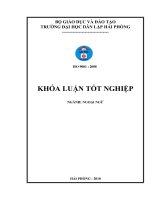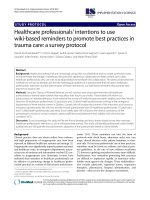Using Games to Promote Communicative Skills in Language Learning
Bạn đang xem bản rút gọn của tài liệu. Xem và tải ngay bản đầy đủ của tài liệu tại đây (67.53 KB, 4 trang )
Using Games to Promote Communicative
Skills in Language Learning
Chen, I-Jung
This article considers the reasons why games serve as excellent communicative activities.
The use of games can be a powerful language learning tool. On the surface, the aim of all
language games is for students to "use the language"; however, during game play learners
also use the target language to persuade and negotiate their way to desired results. This
process involves the productive and receptive skills simultaneously. In this article the
author also shares her experience of some interesting games and their application in the
language classroom.
Introduction
In recent years language researchers and practitioners have shifted their focus from
developing individual linguistic skills to the use of language to achieve the speaker's
objectives. This new area of focus, known as communicative competence, leads language
teachers to seek task-oriented activities that engage their students in creative language use.
Games, which are task-based and have a purpose beyond the production of correct speech,
serve as excellent communicative activities (Saricoban & Metin 2000). On the surface, the
aim of all language games is for students to "use the language"; however, during game play
learners also use the target language to persuade and negotiate their way to desired results.
This process involves the productive and receptive skills simultaneously.
Games offer students a fun-filled and relaxing learning atmosphere. After learning and
practicing new vocabulary, students have the opportunity to use language in a non-stressful
way (Uberman 1998). While playing games, the learners' attention is on the message, not
on the language. Rather than pay attention to the correctness of linguistic forms, most
participants will do all they can to win. This eases the fear of negative evaluation, the
concern of being negatively judged in public, and which is one of the main factors
inhibiting language learners from using the target language in front of other people
(Horwitz, Horwitz and Cope 1986). In a game-oriented context, anxiety is reduced and
speech fluency is generated--thus communicative competence is achieved.
Games are also motivating. Games introduce an element of competition into language-
building activities. This provides valuable impetus to a purposeful use of language (Prasad
2003). In other words, these activities create a meaningful context for language use. The
competitive ambiance also makes learners concentrate and think intensively during the
learning process, which enhances unconscious acquisition of inputs. Most students who
have experienced game-oriented activities hold positive attitudes towards them (Uberman
1998). An action research conducted by Huyen and Nga (2003), students said that they
liked the relaxed atmosphere, the competitiveness, and the motivation that games brought
to the classroom. On the effectiveness of games, teachers in Huyen & Nga's (2003)reported
that action research reported that their students seem to learn more quickly and retain the
learned materials better in a stress-free and comfortable environment.
The benefits of using games in language-learning can be summed up in nine points.
Games....
• are learner centered.
• promote communicative competence.
• create a meaningful context for language use.
• increase learning motivation.
• reduce learning anxiety.
• integrate various linguistic skills.
• encourage creative and spontaneous use of language.
• construct a cooperative learning environment.
• foster participatory attitudes of the students.
Some Fun Games
Based on the advantages discussed above, English teachers in our school designed a
school-wide English competition to help students experience the fun and usefulness of
English. Here I would like to share with other teachers the games we played and some
observations I have made.
Our competition involved major five tasks. Students broke into teams of five members. The
team that finished first was the champion. To further complicate the game, each task station
was hidden in different locations all over campus. Participants only obtained directions to
the next station after completing the present task. This not only offered students a chance to
use their map-reading and problem-solving skills, but it also added a dynamic atmosphere
to the competition. The participants were college freshmen at lower-intermediate language
level (about 18 years old).
The tasks are described as follow:
I. Mysterious Landmarks
1. Competitors assemble a 20-piece jigsaw puzzle of a world famous landmark (such
as the Eiffel Tower, Mt. Fuji the Great Wall, etc).
2. Then they describe puzzle image in five sentences to complete the task.
This game encourages students' productive skills and elicits their speech fluency. Cross-
culture concepts are also addressed. The number, the length, and the patterns of sentence
can vary depending on the students' language ability and linguistic points the instructor
would like to reinforce.
II. What's the Number?
1. Participants use the four basic operations (addition, subtraction, division and
multiplication) to compute a simple mathematical equation provided orally by the
instructor.
2. They call out the correct answer as soon as possible.
This game addresses students' listening skills and tests their understanding of numbers,
which is often an important part of language teaching materials.
III. Story Time
1. Participants pick and listen to a tape randomly selected from a provided stack of
tapes (the recording contains a spoken excerpt of a well-known children's story,
such as the Snow White, the Ginger Bread Man, etc).
2. After listening to the entire excerpt, competitors correctly identify the title of the
story from a provided list.
The recorded stories are all classical bedtime stories for young children and have been
translated into most of the major languages worldwide. Students should be familiar with
those stories. This game focuses on gist-listening skills. Students only need to catch the key
terms to figure out what the story is.
IV. Art Master
1. The instructor describes a picture orally.
2. Competitors simultaneously recreate the picture on a sheet of paper, correctly
including named objects in accurate positions.
This game reinforces the use of prepositions, such as to the right of, to the left of, in the
middle of, or under, etc. It also reinforces the vocabulary of concrete objects students have
already learned before. The complexity of the picture will depend on the level of the
students.
V. What's Cooking?
1. Participants read a recipe and make the dish.
2. The amount of ingredients and assembly process must follow exactly the
instructions laid out in the recipe.
3. The participants eat the dish they have prepared, all together and as fast as possible,
because whoever finishes the five tasks first wins the entire competition.
This game not only reinforces food vocabulary, but it also tests the ability of students to
comprehend written instructions. This is also good for introducing cross-culture topics.
Recipes may vary depending on what food terms and cultures the teachers wishes to cover.
Salads and sandwiches are easy-to-prepare recipes. The eating part adds an additional
element of fun to the game.
Although the whole competition is a combination of five games, each game is suitable for
reinforcement of individual language skills and easily applied in the classroom. One feature
of these games is that students with lower language ability in a team can still contribute if
they are good at skills other than languages, such as putting together jigsaw puzzles,
calculating numbers, drawing, or eating fast.
Observations
Throughout the competition, I observed that students were more engaged in and committed
to using English than they would be in the classroom. They were attentive to instructions,
which they usually are not in regular class. In each of the games, students found their own
ways to express themselves. Participants went all out with their English to win the game.
The games also aroused cultural awareness. After the competition, students told me they
will now pay more attention to geographical names that they often ignored before simply
because they had never been there. Thus, students expressed a motivation and desire to
know more than just linguistic knowledge.
Conclusion
Our experience creating a competition for our students taught us that games stimulate
communicative skills. Competitors revealed that they felt less afraid of using their English
during game play. I also observed that they were more willing to ask questions and think
creatively about how to use English to achieve the goal. The competition gave students a
natural opportunity to work together and communicate using English with each other.
Furthermore, by integrating playing and learning, students practiced the learned linguistic
knowledge in a vivid and meaningful context. Many came to understand that they could
successfully use English to accomplish a variety of tasks. And finally, the competition
stimulated their interest in foreign culture. As Uberman (1998, 87) writes, "Games
encourage, entertain, teach, and promote fluency and communicative skills. If not for any
of these reasons, they should be used just because they help students see beauty in a foreign
language and not just problems that at times seem overwhelming."









